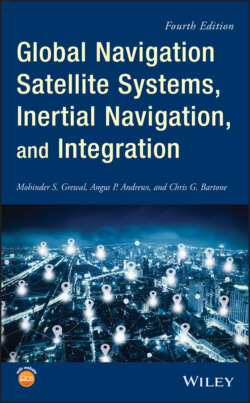Читать книгу Global Navigation Satellite Systems, Inertial Navigation, and Integration - Mohinder S. Grewal - Страница 49
1.4.2 Implementation
ОглавлениеThe Kalman filter solves for the solution with the least mean‐squared error by using data‐weighting proportional to statistical information content (the inverse of uncertainty) in the measured data. It combines GNSS and INS information to the following:
1 Track drifting parameters of the sensors in the INS, so that INS performance does not degrade with time when GNSS is available.
2 Improve overall performance even when there are insufficient satellite signals for obtaining a complete GNSS solution.
3 Allow the INS to navigate with improved initial error whenever GNSS signals become unavailable.
4 Improve GNSS signal reacquisition when GNSS signals become available again by providing better navigation solutions (based on INS data).
5 Use acceleration and attitude rate information from the INS for reducing the signal phase‐tracking filter lags in the GNSS receiver, which can significantly improve GNSS reliability during periods of high maneuvering, jamming, or reduced signal availability.
The more intimate levels of GNSS/INS integration necessarily penetrate deeply into each of the subsystems, in that it makes use of partial results that are not ordinarily accessible to users. To take full advantage of the offered integration potential, we must delve into technical details of the designs of both types of systems.
